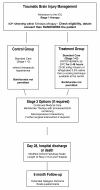European society of intensive care medicine study of therapeutic hypothermia (32-35 °C) for intracranial pressure reduction after traumatic brain injury (the Eurotherm3235Trial)
- PMID: 21226939
- PMCID: PMC3027122
- DOI: 10.1186/1745-6215-12-8
European society of intensive care medicine study of therapeutic hypothermia (32-35 °C) for intracranial pressure reduction after traumatic brain injury (the Eurotherm3235Trial)
Abstract
Background: Traumatic brain injury is a major cause of death and severe disability worldwide with 1,000,000 hospital admissions per annum throughout the European Union.Therapeutic hypothermia to reduce intracranial hypertension may improve patient outcome but key issues are length of hypothermia treatment and speed of re-warming. A recent meta-analysis showed improved outcome when hypothermia was continued for between 48 hours and 5 days and patients were re-warmed slowly (1 °C/4 hours). Previous experience with cooling also appears to be important if complications, which may outweigh the benefits of hypothermia, are to be avoided.
Methods/design: This is a pragmatic, multi-centre randomised controlled trial examining the effects of hypothermia 32-35 °C, titrated to reduce intracranial pressure <20 mmHg, on morbidity and mortality 6 months after traumatic brain injury. The study aims to recruit 1800 patients over 41 months. Enrolment started in April 2010.Participants are randomised to either standard care or standard care with titrated therapeutic hypothermia. Hypothermia is initiated with 20-30 ml/kg of intravenous, refrigerated 0.9% saline and maintained using each centre's usual cooling technique. There is a guideline for detection and treatment of shivering in the intervention group. Hypothermia is maintained for at least 48 hours in the treatment group and continued for as long as is necessary to maintain intracranial pressure <20 mmHg. Intracranial hypertension is defined as an intracranial pressure >20 mmHg in accordance with the Brain Trauma Foundation Guidelines, 2007.
Discussion: The Eurotherm3235Trial is the most important clinical trial in critical care ever conceived by European intensive care medicine, because it was launched and funded by the European Society of Intensive Care Medicine and will be the largest non-commercial randomised controlled trial due to the substantial number of centres required to deliver the target number of patients. It represents a new and fundamental step for intensive care medicine in Europe. Recruitment will continue until January 2013 and interested clinicians from intensive care units worldwide can still join this important collaboration by contacting the Trial Coordinating Team via the trial website http://www.eurotherm3235trial.eu.
Trial registration: Current Controlled Trials ISRCTN34555414.
Figures
References
-
- European Brain Injury Society. European Brain Injury Society. 2004. http://www.ebissociety.org/head-injury.html
-
- American Heart Association. Guidelines for CPR and ECC. Part 7.5 Post-resuscitation support. Circulation. 2005;112(24 Supplement):84–88. IV.
Publication types
MeSH terms
Associated data
Grants and funding
LinkOut - more resources
Full Text Sources
Other Literature Sources
Medical
Miscellaneous



